

|
All Photographs © Sam Oppenheim
|
|||||||||||||
| ||||||||||||||
| |||||||||||||||||
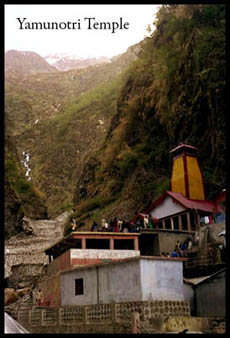
By Sam Oppenheim As I mentioned in my previous travelogue, I spent my last week in India in the Himalayas. On a tight budget I skipped from station to station in crowded busses and jeeps, sometimes crushed between 5 people in a 3 person seating space of the jeep, while others rode on the roof and hung on the back and sides of it; it was a zoo. After two days of non-stop travel by these slower means (they stop whenever someone has to get on or off and run at their own slow pace, the engine groaning uphill) I made it to Yamunotri. Yamunotri is the holy village and temple at the source of the Yamuna river. This is such a beautiful setting, it is a cul-de-sac of mountain peaks and over 25 waterfalls all running together in the valley to form the source of the sacred Yamuna River. To get there one arrives at Phul Chatti and then has to hike 7 kilometers (3.3 miles). Hindu pilgrims who are rich, lazy, old, or out of shape may take donkeys. Some even take the less comfortable and less respectable chairs hoisted by 4 men. Some light women and children sometimes ride on the back of a porter, in a precariously placed basket hung from their forehead. I walked with a 20 kilogram (40 pound) hikers' backpack on me, full of heavy camera equipment and cold weather clothes. 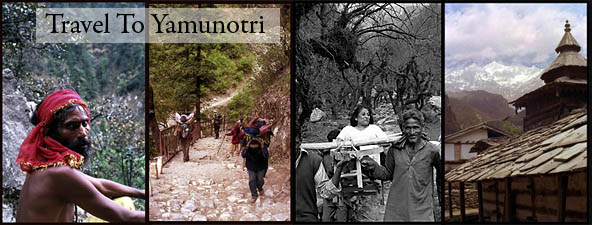 Once at the holy source of the Yamuna river, many pilgrims go to the temple and then turn back to go to Gangotri, the second stop on the "Char Dham" - 4 holy sources of rivers. I stayed at an Ashram in a room while the Israeli couple I met that day put up their tent and cooked tea for everyone on their portable stove. The next day was so beautiful, I wanted to hike further up the mountain. The Israelis warnined that I ought to rest a day at 3,100 meters (9,300 feet) and not hike up alone, however, with a mere 6 days left in India, up I went.
Once at the holy source of the Yamuna river, many pilgrims go to the temple and then turn back to go to Gangotri, the second stop on the "Char Dham" - 4 holy sources of rivers. I stayed at an Ashram in a room while the Israeli couple I met that day put up their tent and cooked tea for everyone on their portable stove. The next day was so beautiful, I wanted to hike further up the mountain. The Israelis warnined that I ought to rest a day at 3,100 meters (9,300 feet) and not hike up alone, however, with a mere 6 days left in India, up I went.After climbing up to 3,600 meters I began to feel some more affects of altitude sickness: difficulty breathing and lightheadedness. Therefore I stopped and took some photographs. Then I meditated for an hour on a rock in the sunshine with a view of 7 waterfalls. The sound of rushing water in the air alongside the beautiful smell of pine trees and spring flowers invigorated my mind and body, so that afterwards I continued uphill. 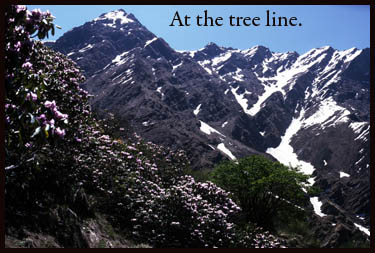 I was in awe at the tree line, there were so many beautiful flowers and butterflies, I knew I was very high up, yet to see so much life made me really love the singular feeling of high altitudes, solitude, and hiking.
I was in awe at the tree line, there were so many beautiful flowers and butterflies, I knew I was very high up, yet to see so much life made me really love the singular feeling of high altitudes, solitude, and hiking.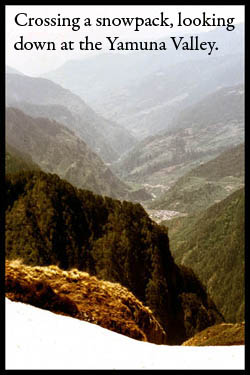 The ascent became steadily more difficult as I got higher and higher beyond the last trees. The whole trail was just one switchback after another. Up, up, and up some more. This trail leads one up the mountains past many waterfalls and up over the Yamuna Pass. This pass is one way over this part of Himalayan mountain range that divides the Yamuna drainage basin from the Beas and Sutlej. All the water on the this side of the mountains drains via the Yamuna river into the Ganges basin in the plains of India and eventually flows to the Bay of Bengal on the East Side of India. On the other side of this mountain, every drop of water finds its way into the Indus River System which drains though Pakistan into the Arabian Gulf.
The ascent became steadily more difficult as I got higher and higher beyond the last trees. The whole trail was just one switchback after another. Up, up, and up some more. This trail leads one up the mountains past many waterfalls and up over the Yamuna Pass. This pass is one way over this part of Himalayan mountain range that divides the Yamuna drainage basin from the Beas and Sutlej. All the water on the this side of the mountains drains via the Yamuna river into the Ganges basin in the plains of India and eventually flows to the Bay of Bengal on the East Side of India. On the other side of this mountain, every drop of water finds its way into the Indus River System which drains though Pakistan into the Arabian Gulf.Finally, I reached a small ice pack -- like a miniature glacier hanging onto the side of the mountain. The snow was packed tight into ice and if one slipped down it, he would end up at the bottom of a waterfall, smashed upon rocks, if he couldn't stop himself on the icy slide down. Therefore I took two birch limbs from a dead tree at the 4,200 meter tree line, and picked footsteps into the ice with the walking sticks. I therefore created my own safe footprints to climb across the glacier. Then I reached another patch of ice and snow and a huge waterfall. At this point I decided I had gone far enough, and that traveling alone was not the safe thing to do so I sat down and wrote into my journal and read my book. 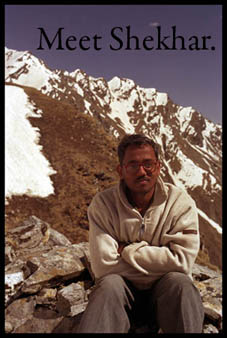 The land in front of me was so different than what I was used to: The waterfall fell into a pocket of icy glacier and plummeted underneath to flow out below in another waterfall, the whole river section between the double waterfalls was covered by ice and snow. Above the falls, both sheer cliffs were decorated by a grassy weed that grows on sheer rock above the tree line in these mountains. It looked like 1,000 dirty blond wigs had been draped on every nook of rock. Below me I could see Yamunotri in the distance: a temple and village of twenty stores and two ashrams. Above Yamunotri was the snaking trail I had come up, twisting through the forest of pine trees and flower bushes, then past the last birch trees at 4,300 meters, and right behind me: three people.
The land in front of me was so different than what I was used to: The waterfall fell into a pocket of icy glacier and plummeted underneath to flow out below in another waterfall, the whole river section between the double waterfalls was covered by ice and snow. Above the falls, both sheer cliffs were decorated by a grassy weed that grows on sheer rock above the tree line in these mountains. It looked like 1,000 dirty blond wigs had been draped on every nook of rock. Below me I could see Yamunotri in the distance: a temple and village of twenty stores and two ashrams. Above Yamunotri was the snaking trail I had come up, twisting through the forest of pine trees and flower bushes, then past the last birch trees at 4,300 meters, and right behind me: three people.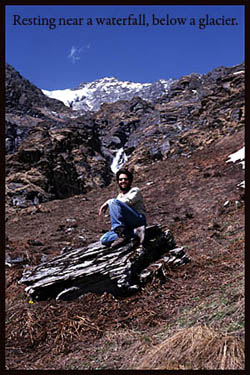 I waved and was soon talking Hindi to a guide and two Indians. These were the first Indians I had ever seen seriously hiking, the beauty and adventure of nature in India is trekked over by far more foreigners than nationals due to cultural differences, although 'adventure tourism' is becoming a booming market worldwide, in India it hasn't attracted many Indians yet. One of the Indians, it ended up, was an English teacher named Shekhar and we quickly became close friends. I could practice Hindi and also more comfortably converse in English with him. We shared many interests including hiking, nature, Ayurveda, and meditation.
I waved and was soon talking Hindi to a guide and two Indians. These were the first Indians I had ever seen seriously hiking, the beauty and adventure of nature in India is trekked over by far more foreigners than nationals due to cultural differences, although 'adventure tourism' is becoming a booming market worldwide, in India it hasn't attracted many Indians yet. One of the Indians, it ended up, was an English teacher named Shekhar and we quickly became close friends. I could practice Hindi and also more comfortably converse in English with him. We shared many interests including hiking, nature, Ayurveda, and meditation.Because I had now met others and they were continuing up further, I felt relatively safe continuing up. We scaled the second glacier and drank from the fresh waterfall waters coming down the rock. Above this point the oxygen became more scarce, but we hiked two full kilometers uphill. Our path wove through the brushy, weedy landscape that was all brown and green, the grasses holding the thin soil to the steep mountainside and providing us with easier walking surfaces than rock and glacier. We zig-zagged up a series of 45 switchbacks in about an hour before coming to another change of scenery, the final series of waterfalls, glaciers, mountain rocks, and natural springs. It was here that I rested face first into a pool of fresh, clean, cold mountain spring water. 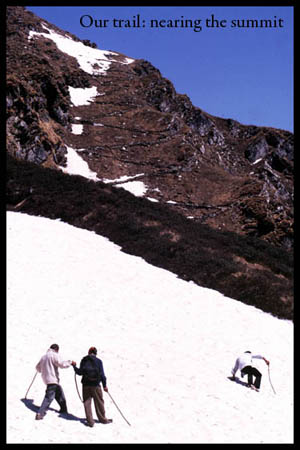 I drank deeply of the best water I had had in a long time. I filled up all my water bottles and left my backpack at the spring, choosing to continue up the rest of the ascent less encumbered. I had hiked up 8 kilometers, to about 5,000 meters, with a 15-18 kilogram backpack on me, all in the name of 'training' my body to be equipped for camping and hiking with gear. Meanwhile my diet had begun to be quite squirrel-like, for two days and the next 4 more I would eat mostly dried fruits and nuts. At dinner, however, I would often find dal and rice at an ashram. The benefit of this was that I toned up my body, felt great, and lost weight while gaining muscle. It was 1:30pm and we had to turn around soon, but we all wanted to ascend to the top of the peak and pass. We had all begun to feel the affects of the high altitude: deep breaths, soreness of all muscles, and the need to rest after nearly every step. Another sign of altitude sickness is sinus or cheek pressure and headaches, both of which I begun to feel as we hiked even higher. 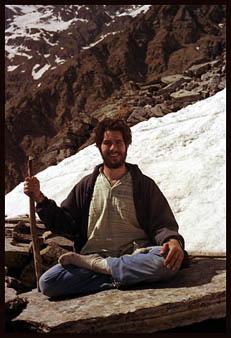 Past the level at which any major life seems to grow, we climbed a stack of slate stone stairs built by Nepali trail builders. Other than us the only life here seemed to be lichen and mosses on the hard, cold rock. Whenever the wind stopped blowing up from the valley we had to rest, as it was our oxygen lifeline, bringing up more oxygen-rich air from the forests 2,000 meters beneath us. Finally we crested a mountain plateau and found the pass too glaciated, blocking the only way to the mountain pass in front of us. It was 3pm and we ought to have turned around by then anyway so we asked our guide to go look at whether further progress was possible without equipment, but we assured him we would turn back, we were just curious.
Past the level at which any major life seems to grow, we climbed a stack of slate stone stairs built by Nepali trail builders. Other than us the only life here seemed to be lichen and mosses on the hard, cold rock. Whenever the wind stopped blowing up from the valley we had to rest, as it was our oxygen lifeline, bringing up more oxygen-rich air from the forests 2,000 meters beneath us. Finally we crested a mountain plateau and found the pass too glaciated, blocking the only way to the mountain pass in front of us. It was 3pm and we ought to have turned around by then anyway so we asked our guide to go look at whether further progress was possible without equipment, but we assured him we would turn back, we were just curious.From these flat slate rocks above 5,400 meters, we lay down on our backs and watched an amazing dance choreography in the clouds which were so close you could touch them.  The cross winds at the tops of mountains create odd weather patterns as winds rising from valleys meet winds rushing horizontally across and around the whole world. The clouds were pulled in all directions at once and we watched two small clouds mix together like sediments stirred into a water glass. Then, in a serene place, at heights I never imagined I could climb to, I meditated for 5 minutes and enjoyed the peace of mind in a place where only god belongs, and we were merely momentary guests in his house. The cross winds at the tops of mountains create odd weather patterns as winds rising from valleys meet winds rushing horizontally across and around the whole world. The clouds were pulled in all directions at once and we watched two small clouds mix together like sediments stirred into a water glass. Then, in a serene place, at heights I never imagined I could climb to, I meditated for 5 minutes and enjoyed the peace of mind in a place where only god belongs, and we were merely momentary guests in his house.On the climb back down we all reflected on the amazing experience, we had climbed to a height, by foot, higher than I had flown to and jumped out of an airplane when I skydove. We went above the vegetation line, the flower line, the tree line, the oxygen was so thin my lungs were sore the whole next day, as were all my muscles, but it felt so GOOD! Walking down the hill, at times running, we embraced our lives, our bodies, our oxygen, our soul. All that makes life worth experiencing became vivid to us as the oxygen increased in our bloodstream. We saw quails and birds come back from winter migrations, butterflies playing in newly blossomed flowers on the mountainside. Finally we watched the sunset through the lower levels of a pine forest as we approached Yamunotri.  Yamunotri is also blessed with a natural hot spring, so with a relaxing plunge, our muscles and bodies were bathed and rejuvenated with sulfurous warm water. Although Shekhar's hotel was distant, we had made such a connection during our hike, as I bade him farewell I promised to meet him tomorrow morning to travel together to Gangotri.
Yamunotri is also blessed with a natural hot spring, so with a relaxing plunge, our muscles and bodies were bathed and rejuvenated with sulfurous warm water. Although Shekhar's hotel was distant, we had made such a connection during our hike, as I bade him farewell I promised to meet him tomorrow morning to travel together to Gangotri.
Somehow I managed to arouse my sore body and talk it into hiking another 7 kilometers downhill at 7am, finding Shekhar waiting for me at his Hotel, we took a detour to a quaint old himalayan village and visited a beautiful old wooden temple in the village. We then bade goodbye to the Yamuna valley and continued via jeep to Uttarkashi. Soon we found our way to Gangotri .... (continued) |